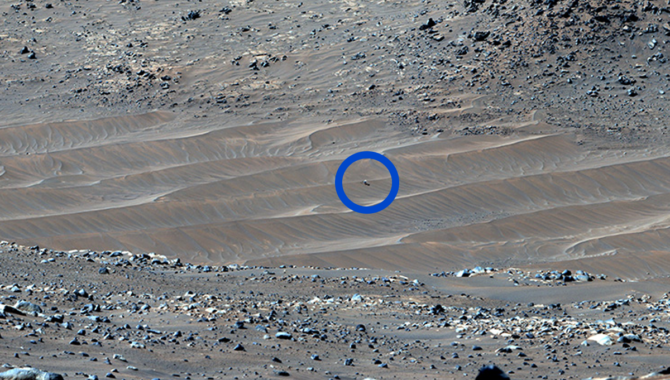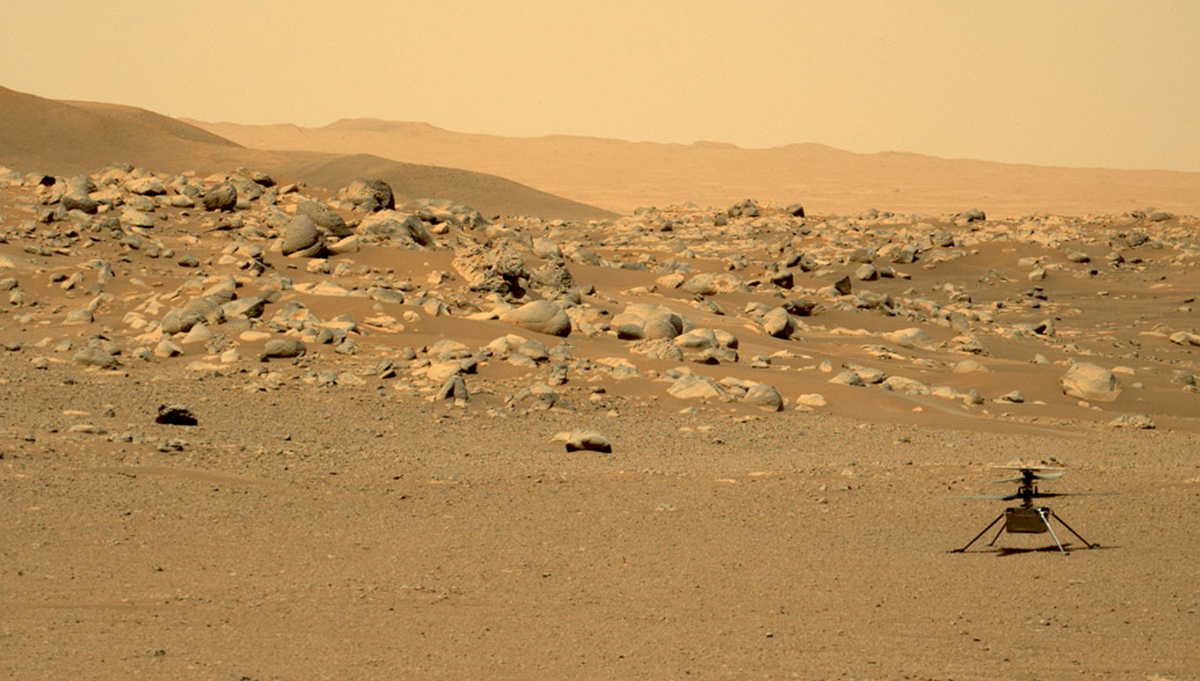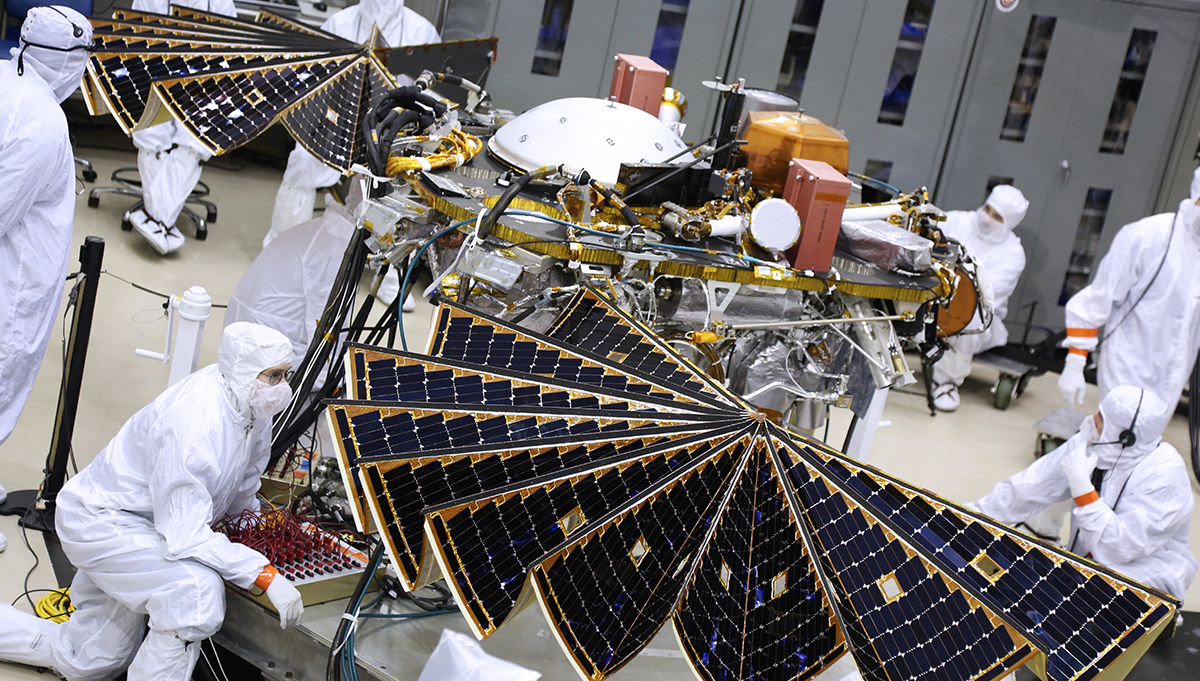
NASA’s Perseverance Mars rover captured this mosaic showing the Ingenuity Mars Helicopter (circled) at its final airfield on Feb. 4, 2024. The helicopter damaged its rotor blades during the landing of its 72nd flight on January 18, 2024. Photo Credit: NASA/JPL-Caltech/ASU/MSSS
Small helicopter carried Wright Brothers’ fabric far beyond Earth as it pioneered flight on another planet in the solar system.
In 1903, two bright, ambitious inventors walked into a department store in Dayton, Ohio, to purchase a large quantity of Pride of the West Muslin, a lightweight cotton fabric that was commonly used to make undergarments at the time. They had no way of knowing how many future aviators would come to revere that fabric and how incredibly far it would go.

Orville Wright during the first powered flight of a heavier-than-air aircraft.
Photo Credit: National Park Service
That muslin was stretched over the wooden frame of an airplane that Wilbur Wright brought in for a hard landing on the sand dunes outside Kitty Hawk, North Carolina, on December 17, 1903. This fourth flight covered 852 ft. in 59 seconds, but the landing snapped the plane’s front elevator supports. As Wilbur and his brother Orville discussed extending the momentous day with quick repairs, a strong wind violently flipped the 605-pound plane, further damaging it. The first day of controlled, sustained flights by a heavier-than-air craft was over.
Decades later, a young boy in Wapakoneta, Ohio, became fascinated with the rapidly advancing field of aviation, poring over the letters, memos, and recorded statements of the Wright Brothers about that pivotal Thursday in 1903. This boy would go on to become an accomplished aviator, reaching a maximum altitude of 207,000 feet. When it was time for Neil A. Armstrong to fill a small bag with items of personal significance that he would take on the first attempt to land on the Moon, he included a piece of the Wright Brothers’ muslin.
Earlier this month, a four-pound rotorcraft hovering over featureless terrain began a controlled descent to the surface of Mars. Three feet above the ground, on this 72nd flight, the helicopter lost communication and likely came in for a hard landing on the rippled sand of Jezero Crater. It is believed that the helicopter, Ingenuity, suffered a blade strike with the surface, shattering a section of the blade and leaving the craft unable to fly. The first flights of a human aircraft on another planet had come to an end.
Tucked beneath Ingenuity’s solar panel, secured around a cable, is a postage-stamp-sized piece of Orville and Wilbur Wright’s muslin, where it will remain on Mars for millennia, as far as 249 million miles from the now defunct department store in Dayton, Ohio, where it was purchased 121 years ago.
“It’s humbling Ingenuity not only carries onboard a swatch from the original Wright Flyer, but also this helicopter followed in its footsteps and proved flight is possible on another world,” said Ingenuity’s project manager, Teddy Tzanetos of NASA’s JPL.
“… new generations of Mars helicopters are on the drawing board, and we’re excited for what the future will hold in the skies of Mars.”
“[The Wright Brothers] unlocked the skies on Earth, made it commonplace to fly, part of our everyday lives. We all truly believe that Ingenuity has done the same for Mars. It’s now unlocked the aerial exploration dimension and we couldn’t be prouder of our little tough trailblazer. While Ingenuity is not going to fly again, new generations of Mars helicopters are on the drawing board, and we’re excited for what the future will hold in the skies of Mars,” said Tzanetos, speaking at a NASA media briefing.
Ingenuity arrived at Mars on February 18, 2021, tucked beneath the Perseverance Rover, landing at a site just north of the Martian equator in an area of geological diversity that had intrigued scientists for decades. Ingenuity is about 19 inches high. Its twin, counter-rotating blades span approximately 4 feet, spinning at 2,537 revolutions per minute in the thin Martian atmosphere.

NASA’s Ingenuity Mars Helicopter is viewed here through the Remote Microscopic Imager (RMI) camera, part of the SuperCam instrument aboard NASA’s Perseverance rover. This image was taken on May 14, 2021, the 82nd Martian day, or sol, of the mission.
Photo Credit: NASA/JPL
The team scouted the surrounding area for a suitable airfield. Dropping the debris shield that protected Ingenuity, the team began intricate deployments to place Ingenuity on the Martian surface on April 4, 2021. The team shifted the helicopter from a horizontal to upright position, and unlocked the landing legs, allowing them to snap into place. After one last electrical charge from Perseverance, Ingenuity was dropped a short distance to the surface of Mars, and Perseverance pulled back to a safe observational distance.
On April 19, 2021, Ingenuity became the first human aircraft to make a powered, controlled flight on another planet, overcoming the challenges of the weak Martian gravity and thin atmosphere. By May 7, 2021, the team had successfully completed the mission’s five test flights, and Ingenuity entered a new, extended operations phase in which it flew as an aerial scout, demonstrating how this capacity could support the Perseverance Rover and future missions to Mars.
“We never planned for such a long mission,” Tzanetos said. “We originally had a single logbook, hoping for one successful flight to be logged in that logbook. Eventually got to five [flights] and were extremely excited to proceed into our extended operations demonstration. We now have a fully packed logbook and a second volume … to capture all the rest, leading all the way up to now, finally, flight 72. We’ve had amazing luck along the way. We can’t forget that we’ve been extremely lucky to be flying this long at Mars and to have to deal with the cold winters, dust storms, and an infinite amount of curve balls that Mars always throws at you when you try to operate a spacecraft so, so far away.”
With all the data filling Ingenuity’s logbook, NASA may not get a complete picture of what brought Ingenuity to the ground on January 18.
“Because we lost communications with the helicopter during descent, the full high-rate data log that we typically get during flights is not available. We won’t be able to get that log back,” said Tzanetos. “Whether or not the blade strike occurred, which led to the communications loss or there was a communications loss and a power brownout, which then led to the rotor strike, we will never know.”
To learn more about Ingenuity, listen to this Small Steps, Giant Leaps podcast with Ingenuity Chief Engineer Bob Balaram, and this episode with Chief Pilot Håvard Grip, or visit the Ingenuity mission website.









